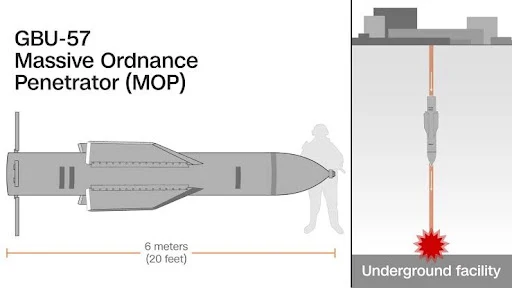U.S. Executes Overnight Stealth Airstrike on Iran’s Strategic Infrastructure
In a dramatic escalation of tensions in the Middle East, the United States launched a covert precision strike on key Iranian military and nuclear facilities in the early hours of June 22. The operation was carried out by B-2 Spirit stealth bombers, equipped with GBU-57 Massive Ordnance Penetrators (MOPs)—bunker-busting munitions designed to destroy deeply buried targets.
The strike, which came without prior warning, has shocked both allies and adversaries in the region.
How the Operation Unfolded
At least three B-2 bombers were deployed from the U.S. base on Diego Garcia in the Indian Ocean, supported by KC-135 aerial refueling tankers.
Airspace Route:
The bombers flew a low-observable path, reportedly through international airspace over the Persian Gulf, avoiding early detection by Iranian radar systems.
Time of Impact:
Explosions were first reported at approximately 02:17 AM local time, with multiple tremors recorded near Qom, Natanz, and Esfahan.
Confirmed Target Zones
1. Fordow Fuel Enrichment Plant – Qom
Built into a mountain, previously considered immune to airstrikes.
Struck with at least one GBU-57, causing a partial collapse of underground tunnels.
Early satellite imagery shows significant structural damage.
2. Natanz Enrichment Facility – Isfahan Province
Iran’s most advanced centrifuge site.
Hit by multiple penetrator warheads; fire and smoke visible from miles away.
3. Ballistic Missile Production Facility – Near Esfahan
U.S. intelligence claims it housed Shahab-3 development units.
Destroyed storage hangars and fuel depots confirmed via thermal imagery.
4. Air Defense Radar Station – Western Iran
Neutralized early in the operation to blind Iranian air surveillance.
Paves the way for a possible follow-up strike.
Tactical Analysis
Experts believe the strike was intended to:
Degrade Iran’s second-strike capability in the event of war.
Delay uranium enrichment timelines after recent IAEA reports indicated Tehran was enriching uranium up to 90% purity.
Signal overwhelming U.S. deterrence against future IRGC-backed proxy attacks on U.S. interests.
Global Reaction
Iran:
The Iranian Defense Ministry has confirmed “limited damage” and vowed retaliation. State media showed footage of missile batteries firing into the night sky but have not admitted any site losses.
Israel & Gulf Allies:
No official comment, though sources suggest regional coordination and prior warning may have been provided to key U.S. allies.
Russia & China:
Condemned the strike, calling it a violation of international law and a “reckless provocation.”
UN Security Council:
An emergency session is expected within 48 hours.
What Happens Next?
Military analysts suggest the U.S. may be preparing for Phase 2—potentially targeting IRGC missile silos or command centers. Cyber operations may already be underway to further weaken Iran’s retaliatory capabilities.
A senior Pentagon source stated anonymously:
“This was a decisive message. Iran's most fortified sites are no longer untouchable.”
Editorial Insight
This strike marks the most significant U.S. direct action on Iranian soil since the assassination of Qassem Soleimani in 2020. Unlike drone strikes or sanctions, this operation showcases the full strategic reach of American stealth and precision bombing technology in a modern theater of war.






